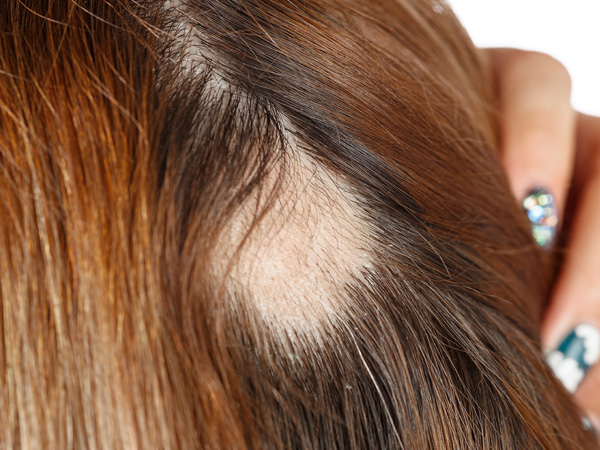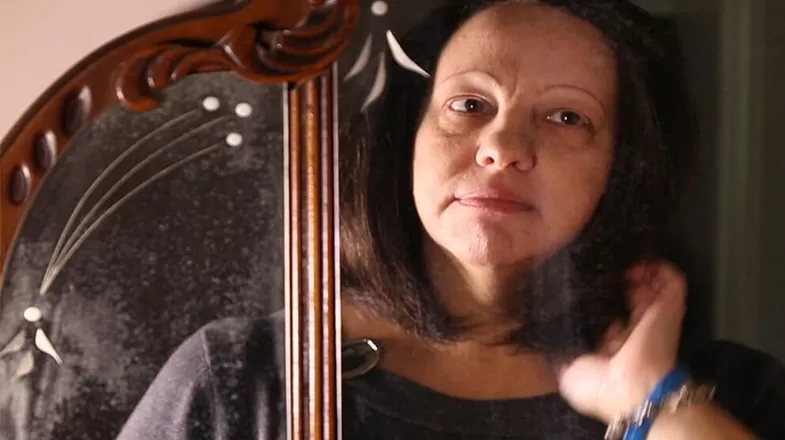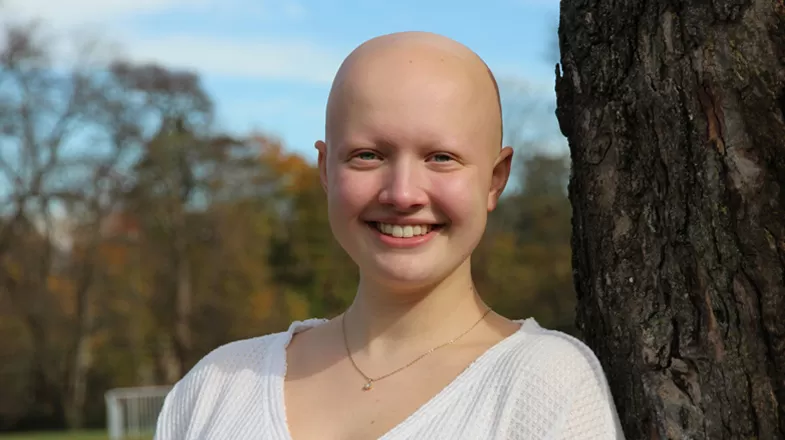- Home
- Science
- Diseases & Conditions
- Alopecia Areata
What Is Alopecia?
The word alopecia is derived from the Latin word for baldness.1 As an umbrella term, alopecia can apply to many types of hair loss.2 For example, the most common form of alopecia is androgenetic alopecia.1,3
Alopecia areata, however, differs from androgenetic alopecia and other types of alopecia, as it is an autoimmune disease. It occurs when a person’s immune system attacks their own hair follicles.1,2
What Is Alopecia Areata?
Alopecia areata is an autoimmune disease.1 Autoimmune diseases are conditions in which a person’s immune system attacks other tissues in their body. Researchers aren’t sure of the precise cause of autoimmune diseases, but some potential triggers may include bacteria, viruses, and medications. It’s also possible that a person’s genes can make them more likely to have an autoimmune disease.8
More than 80 types of autoimmune diseases exist and affect different organs and tissues,8 but alopecia areata affects hair follicles.1 These tiny structures sit just below the surface of the skin, producing different types of hair depending on their location on the body.9 Our bodies are covered in hair follicles, so alopecia areata can strike anywhere. It typically affects hair on the head and face.4
When hair begins to fall out, it sometimes does so in round, quarter-sized patches, though affected areas can be larger. For some people, this hair loss is a one-time event. For others, alopecia areata comes and goes and can last a lifetime. Each person may have a different experience with alopecia areata. Some people may regrow hair, while others do not.4 Hair regrowth can be spontaneous,10 or it can happen following treatment.11
There is no cure for alopecia areata, which affects an estimated 2% of the global population.4,12 And treatments were very limited until June 2022, when the United States Food and Drug Administration (FDA) approved a new medication for adults who have severe cases of alopecia areata.13 Fortunately, treatments can help regrow hair.11
Alopecia areata can be triggered by environmental factors like stress, injury, or illness. But in many cases, there is no clear answer as to why someone develops alopecia areata.1 However, researchers have begun to understand the science behind the disease. In addition to determining that alopecia areata is an autoimmune disease, researchers have identified a group of genes, the human leukocyte antigen (HLA) complex, associated with the condition. Variations to genes in the HLA complex may contribute to the disease. Additionally, alopecia areata appears to have some association with other autoimmune diseases, including vitiligo, lupus, and atopic dermatitis (a type of eczema).1,14
Alopecia areata may begin in childhood but can start at any age.2,15 In total, an estimated 6.7 million people in the United States and 160 million people globally have alopecia areata.16
This condition affects some populations disproportionately. For example, in the United States, Black people are more likely to have it than white people. Asian people, meanwhile, are less likely to have alopecia areata than white people.17
Patterns of Alopecia Areata
The distinct types of alopecia areata affect hair in different ways and affect people in different numbers.
Patchy alopecia areata is the most common type of alopecia areata. In this form of the disease, hair typically falls out in round patches about the size of a coin. Patchy alopecia areata often occurs on the scalp, leaving behind bare patches of skin. It can also appear on other parts of the body, such as the beard area.1,4
Unlike patchy alopecia areata, which involves losing separated quarter -sized patches of hair, often on the scalp,3 alopecia totalis causes a total scalp hair loss.18 The outlook for alopecia totalis tends to be comparatively poorer than patchy alopecia areata, with fewer people spontaneously experiencing hair regrowth.18
An estimated .08% of the global population has alopecia totalis.19 It’s more common among children and young adults, but alopecia totalis can occur at any age. Like general alopecia areata, alopecia totalis also affects all genders in equal numbers.18
Alopecia universalis results in total body hair loss (not just the scalp, as in alopecia totalis).4,18 Alopecia universalis affects fewer than 200,000 people in the United States.20
The severity of alopecia areata may predict a person’s likelihood of the disease progressing to alopecia universalis. For example, one study found that people with more severe cases of alopecia areata were more likely to see their cases progress to alopecia totalis or alopecia universalis.12,21
Prevalence of Alopecia Areata
An estimated 6.7 million people in the United States and 160 million people worldwide have alopecia areata, which carries a lifetime risk of 2%.16 That estimated lifetime risk for children varies slightly, spanning from 1% to 2%.22
Alopecia areata is equally prevalent among all sexes and can occur at any age.2,15 One study estimated that the mean ages at time of alopecia areata diagnosis were 31 years for people assigned male at birth and 36 years for people assigned female at birth.23
Alopecia areata may run in families. Researchers estimate that between 0% and nearly 9% of adults who have alopecia areata also have a family member with the autoimmune disease. Evidence also indicates a possible association with certain other autoimmune diseases. People with alopecia areata face a 16% increased risk of these other autoimmune diseases, including autoimmune thyroid disease, vitiligo, and lupus erythematosus. In 39% of alopecia areata cases, the patient also has atopic dermatitis, a type of eczema.14,24
Causes and Risk Factors

What Causes Alopecia Areata?
Classified as an autoimmune disease, alopecia areata is the product of a person’s immune system attacking their own hair follicles, causing hair to fall out. Researchers have made progress in understanding this disease, but work remains to be done. It appears that some genetic and environmental factors may contribute to alopecia areata.1,4
Alopecia Areata and Genetics
Genes appear to play a role in who gets alopecia areata.2,24 For example, one study found that among groups of identical twins with the disease, 42% to 55% of the time, both twins have it.25,26
Analysis of the human genome has shed some light on the genetic underpinnings of alopecia areata. We now know that the autoimmune disease may have an association with a specific gene in the human leukocyte antigen (HLA) complex.24 Playing a critical role in the body’s defense system, the HLA complex helps discern between proteins typically occurring in the body and proteins from foreign invaders. Researchers suspect that variations in the HLA complex may spur the immune system to attack hair follicles, leading to alopecia areata.1
Alopecia Areata Risk Factors
As an immuno-inflammatory disease, alopecia areata is sometimes associated with other autoimmune diseases. Some of the same genetic variations linked to alopecia areata are also linked to other autoimmune diseases. This means that there may be some overlap among genetic risk factors.1
For example, people with alopecia areata may face increased risk of:
- Vitiligo
A disease that affects the color of the skin, leaving patches or spots that are lighter in shade1,24,27. Read more about vitiligo.
- Systemic lupus erythematosus
A disease that causes inflammation throughout bodily tissues and organs1,28. Read more about lupus.
- Allergic asthma
A condition in which allergens, such as mold or pollen, trigger asthma symptoms, including difficulty breathing, chest constriction, or cough1,29
- Hashimoto thyroiditis
A condition that causes chronic thyroid inflammation, limiting the gland’s ability to produce hormones over time1,30
- Graves disease
A condition that causes the thyroid to become overactive1,31
Likewise, people with these diseases may also face an increased risk of alopecia areata.1
The triggers for the onset of alopecia areata remain unclear. It’s possible that illness, emotional stress, or injury can trigger the immune response that leads to the disease.1
In one study, certain factors were predictive of more severe disease. Those factors included changes to the nails (including ridges or pitting) and alopecia areata that continues for more than a year.32
Alopecia Areata Prevention
As an autoimmune disease with unclear causes, there are no known ways to prevent alopecia areata.33
Types of Alopecia
Patchy alopecia areata, alopecia totalis, and alopecia universalis are the predominant types of alopecia areata.4 Three types of alopecia that are not autoimmune diseases are:2
- Androgenetic alopecia
This type of alopecia is often called “male-pattern baldness” when it occurs in people assigned male at birth. People with this condition may experience hair loss dispersed over the entire scalp. However, androgenetic alopecia also occurs in those assigned female at birth, who may experience thinning hair over the entire scalp without a receding hairline.3
- Traction alopecia
Traction alopecia stems from how people wear their hair. Certain styles, such as those that pull hair at the root, can cause hair to fall out over time. Typically, traction alopecia occurs in people assigned female at birth who are of African descent and who may wear their hair in tight braids.5
- Frontal fibrosing alopecia
In frontal fibrosing alopecia, hair loss occurs slowly and scars the scalp around the forehead. It can also affect hair in different places on the body, including the eyelashes and eyebrows. The precise cause of frontal fibrosing alopecia has not been identified.6 It’s classified as a type of lichen planopilaris, another scarring type of scalp condition that can produce different hair-loss patterns. 7
Alopecia Areata Symptoms

An early symptom of alopecia areata is hair loss, which appears suddenly in round or oval patches on the scalp. Patches rarely show signs of scarring, rash, or redness. Sometimes hairs with wide tips and narrow bases, called exclamation point hairs, surround the patches. Patients occasionally report itching, tingling, or burning sensations at these sites before their hair falls out.4
In addition to hair changes, alopecia areata can also affect the nails, leading to ridges or pits. These symptoms are common in people who tend to lose more hair.4 The disease also may affect the beard, eyebrows, or eyelashes. Most often, it appears as patches on the scalp.1
After a scalp patch forms, alopecia areata progression can vary.4 Since this disease doesn’t destroy hair follicles,1 some people may regrow hair later.1,4 This hair regrowth may be white or gray and then return to a person’s natural hair color. Other people may develop additional patches while hair regrows in the original patch. Sometimes small patches of hair loss begin to connect, leading to bigger patches that can progress to alopecia totalis. In rare instances, a person loses all of their body hair to alopecia universalis.4
Most people with alopecia areata regrow hair but experience episodes of hair loss. People who experience more regrowth tend to have several common characteristics:4
- Less extensive hair loss
- Onset of the condition later in life
- No changes to fingernails or toenails
- No family history of the condition
Diagnosis and Treatment
Alopecia Areata Treatment
Often, when a person experiences alopecia areata symptoms, a dermatologist may check their hair and nails for signs of the disease and may use a dermascope (also called a dermatoscope), to closely study the scalp.34 A dermascope is a hand-held visual magnification device that healthcare professionals use to evaluate skin lesions.35 In some cases, doctors may order a blood test to learn more.34
Upon diagnosis, a dermatologist may wait to initiate treatment to see if hair may regrow on its own. If treatment is required, options will depend on several factors, which may include:36
- Age
- Extent of hair loss
- Location of hair loss
Not everyone responds to treatment in the same ways, and the dermatologist may try multiple treatments to alleviate symptoms.36
Treatment options may include:34
- Topical therapies (creams or ointments), which are applied directly to the skin
- Injectable therapies
- Systemic therapies (pills), which affect the immune system
Some of these medications may be prescribed off label, meaning that, although they are not approved by the FDA to treat alopecia areata, they have been approved to treat other conditions.36 Patients should discuss available treatment options and create a treatment plan with their doctor.11,16
Because alopecia areata can be a distressing disease,1 self-care can be a critical part of living with alopecia areata. Some self-care options are cosmetic but may offer comfort. For example, some people with alopecia areata choose to wear wigs or hairpieces. Others may opt to shave their heads.11
People with alopecia areata may consider applying sunscreen to their scalps or keeping their heads covered to shield themselves from the sun’s damaging rays.11 For people who have lost their eyelashes or eyebrows, applying false eyelashes or stick-on eyebrows or wearing sunglasses may help protect the eyes.11
Because people with alopecia areata have a greater risk of developing other conditions, the National Institute of Arthritis and Musculoskeletal and Skin Diseases suggests that people with alopecia areata should continue to maintain their routine medical care. They may also want to consider seeking support for distressing emotions and experiences relating to alopecia areata.11
Global Impact of Alopecia Areata

Alopecia areata affects about 160 million people worldwide.15 Researchers have estimated that the lifetime incidence of the autoimmune disease is 2%.37
To assess the burden of alopecia areata, researchers have used a measurement called global disability-adjusted life years (DALYs).38 According to the World Health Organization, DALYs are a measurement that accounts for time lost due to struggles with illness or disability as well as time lost due to premature death.39 In 2010, the number of global DALYs for alopecia areata was 1,332,800.37 Another study estimated that the global DALY rate per 100,000 people was 7.51 in 2019. The same study found that the DALY rate declined from 1990 to 2010, but the declines were modest.39
In a study that surveyed 176 people with alopecia areata in Iran, researchers determined that study participants with severe cases had higher rates of unemployment and more unstable courses of disease.40
A Canadian study of people with alopecia areata and their caregivers found that 95% “felt uncomfortable or self-conscious" about how they looked. More than half (57%) of pediatric patients and 65% of adult patients said that they avoided social gatherings and constantly worry about whether they’ll lose more hair or regrow hair.41
Frequently Asked Questions About Alopecia Areata
- Is alopecia areata genetic?
Genetics may play a role in alopecia areata. For example, if a person has a family member who has the autoimmune disease, that individual may face a higher risk of alopecia areata.4 One study with identical twins found that both twins had the condition in 42% to 55% of cases.25,26 However, in many cases, there is no family history of alopecia areata.4
Evidence suggests that alopecia areata may be linked to genes in the human leukocyte antigen (HLA) complex, which plays an important role in managing the immune system.1 Variations within these genes may trigger the inflammatory attack on hair follicles that causes this condition.1
- Is alopecia areata an autoimmune disease?
Yes, alopecia areata is an autoimmune disease.1 It happens when a person’s immune system attacks their own hair follicles, leading to hair loss.4
There also appears to be an association between alopecia areata and other autoimmune diseases, such as vitiligo, lupus, and atopic dermatitis (a kind of eczem a).1,14 People with this condition also contend with an increased risk of developing these autoimmune diseases.24
- Is alopecia areata contagious?
No, alopecia areata is not contagious.33 Researchers have yet to determine the precise cause of the condition, but to date, they’ve established that it’s an autoimmune disease, possibly caused by environmental factors, and therefore not a contagious disease. It is possible that certain genes may make a person more likely to have it.1,8
- What causes alopecia areata in women?
Alopecia areata affects all genders in equal numbers. It occurs when something goes awry with the immune system, prompting the immune system to attack hair follicles. Hair falls out, but the hair follicle remains intact.1 Over time, people with alopecia areata may spontaneously regrow hair.3,42
- How does alopecia start?
Alopecia areata’s onset typically involves the sudden formation of round or oval-shaped patches of hair loss on the scalp. But the autoimmune disease may affect other body hair too, including the beard, eyebrows, or eyelashes. Hair loss typically is not accompanied by a rash, scarring, or redness, but some people report tingling, burning, or itching feelings in the areas right before they begin to lose hair.4
Explore alopecia clinical trials at ClinicalTrials.gov.
Area of Focus: Inflammation & Immunology
Alopecia Areata is a focus of Pfizer’s Inflammation & Immunology Therapeutic Area. Visit the Inflammation & Immunology Page.
- Reflections of Alopecia Areata
- Addressing Knowledge Gaps in Alopecia Areata and Atopic Dermatitis
- Pipeline Discoveries for Autoimmune Diseases and Chronic Inflammation
- Challenges in Alopecia Areata and Opportunities to Drive Change: A Global Multi-Stakeholder Consensus Whitepaper
- The Challenges and Misconceptions of Alopecia Areata
- References
- Alopecia areata. MedlinePlus. National Library of Medicine. https://medlineplus.gov/genetics/condition/alopecia-areata/. Updated June 1, 2018. Accessed April 5, 2023.
- Aboud A, Zito P. Alopecia. StatPearls. National Library of Medicine. https://www.ncbi.nlm.nih.gov/books/NBK538178/. Updated March 7, 2023. Accessed April 6, 2023.
- Androgenetic alopecia. MedlinePlus. National Library of Medicine. https://medlineplus.gov/genetics/condition/androgenetic-alopecia/. Updated August 1, 2015. Accessed April 5, 2023.
- Alopecia areata: Overview, symptoms, & causes. National Institute of Arthritis and Musculoskeletal and Skin Diseases. https://www.niams.nih.gov/health-topics/alopecia-areata. Updated April 2021. Accessed April 5, 2023.
- Pulickal, J. Kaliyadan, F. Traction alopecia. StatPearls. https://www.ncbi.nlm.nih.gov/books/NBK470434/. Updated August 8, 2022. Accessed April 5, 2022.
- Frontal fibrosing alopecia. National Center for Advancing Translational Sciences. https://rarediseases.info.nih.gov/diseases/10886/frontal-fibrosing-alopecia. Updated February 2023. Accessed April 5, 2023.
- Lepe K, Nassereddin A, Salazar F. Lichen planopilaris. StatPearls. National Library of Medicine. https://www.ncbi.nlm.nih.gov/books/NBK470325/. Updated November 22, 2021. Accessed April 5, 2023.
- Autoimmune disorders. MedlinePlus. National Library of Medicine. https://medlineplus.gov/ency/article/000816.htm. Accessed April 5, 2023.
- Martel J, Miao J, Badri T. Anatomy, hair follicle. StatPearls. https://www.ncbi.nlm.nih.gov/books/NBK470321/. Updated October 10, 2022. Accessed April 5, 2023.
- Akritidou F, Misiou K, Tsanidou E, Katsaras GN, Papamitsou T. Unexpected hair regrowth in a woman with longstanding Alopecia universalis. GMS Ophthalmology Cases; 11:Doc08. Published online May 11, 2021.
- Alopecia areata: Diagnosis, treatment, and steps to take. https://www.niams.nih.gov/health-topics/alopecia-areata/diagnosis-treatment-and-steps-to-take. National Institute of Arthritis and Musculoskeletal and Skin Diseases. Updated April 2021. Accessed April 5, 2023.
- Pratt CH, King LE, Messenger AG, Christiano AM, Sundberg JP. Alopecia areata. Nat Rev Dis Primers. 2017;3(1):17011.
- FDA approves first systemic treatment for alopecia areata. U.S. Food & Drug Administration. https://www.fda.gov/news-events/press-announcements/fda-approves-first-systemic-treatment-alopecia-areata. June 13, 2022. Accessed April 5, 2023.
- Kolb L, Ferrer-Bruker S. Atopic Dermatitis. StatPearls. National Library of Medicine. https://www.ncbi.nlm.nih.gov/books/NBK448071/. Updated August 8, 2022. Accessed April 6, 2023.
- Alopecia areata. National Organization for Rare Disorders. https://rarediseases.org/rare-diseases/alopecia-areata/. Accessed April 5, 2023.
- What you need to know about alopecia areata. National Alopecia Areata Foundation. https://www.naaf.org/alopecia-areata. Accessed April 5, 2023.
- Lee H, Jung SJ, Patel AB, Thompson JM, Qureshi A, Cho E. Racial characteristics of alopecia areata in the United States. J Am Acad Dermatol. 2020;83(4):1064-1070.
- Abbott J, Rapini R. Totalis alopecia. StatPearls. National Library of Medicine. https://www.ncbi.nlm.nih.gov/books/NBK563225/. Updated February 5, 2023. Accessed April 5, 2023.
- Lee HH, Gwillim E, Patel KR, et al. Epidemiology of alopecia areata, ophiasis, totalis, and universalis: A systematic review and meta-analysis. Journal of the American Academy of Dermatology. 2020;82(3):675-682.
- Alopecia universalis. National Center for Advancing Translational Sciences. https://rarediseases.info.nih.gov/diseases/614/alopecia-universalis. Updated February 2023. Accessed April 5, 2023.
- Tosti A, Bellavista S, Iorizzo M. Alopecia areata: A long term follow-up study of 191 patients. Journal of the American Academy of Dermatology. 2006;55(3):438-441.
- Afford R, Leung AKC, Lam JM. Pediatric alopecia areata. CPR. 2021;17(1):45-54.
- Mirzoyev SA, Schrum AG, Davis MDP, Torgerson RR. Lifetime incidence risk of alopecia areata estimated at 2. 1% by Rochester epidemiology project, 1990–2009. Journal of Investigative Dermatology. 2014;134(4):1141-1142.
- Lepe K, Zito P. Alopecia Areata. StatPearls. National Library of Medicine. https://www.ncbi.nlm.nih.gov/books/NBK537000/. Updated march 7, 2023. Accessed April 5, 2023.
- Jackow C, Puffer N, Hordinsky M, Nelson J, Tarrand J, Duvic M. Alopecia areata and cytomegalovirus infection in twins: Genes versus environment? Journal of the American Academy of Dermatology. 1998;38(3):418-425.
- Rodriguez TA, Fernandes KE, Dresser KL, Duvic M. Concordance rate of alopecia areata in identical twins supports both genetic and environmental factors. Journal of the American Academy of Dermatology. 2010;62(3):525-527.
- Vitiligo: Overview. AADA. https://www.aad.org/public/diseases/a-z/vitiligo-overview. Updated June 29, 2022. Accessed April 5, 2023.
- Systemic lupus erythematosus (SLE). https://www.cdc.gov/lupus/facts/detailed.html. Centers for Disease Control & Prevention. Updated July 5, 2022. Accessed April 5, 2023.
- Allergens and allergic asthma. Asthma and Allergy Foundation of America. https://aafa.org/asthma/asthma-triggers-causes/allergic-asthma/. Accessed April 5, 2023.
- Hashimoto’s thyroiditis (lymphocytic thyroiditis). American Thyroid Association. https://www.thyroid.org/hashimotos-thyroiditis/. Accessed December 7, 2022.
- Graves’ disease. American Thyroid Association. https://www.thyroid.org/graves-disease/. Accessed April 5, 2023.
- You HR, Kim SJ. Factors associated with severity of alopecia areata. Ann Dermatol. 2017;29(5):565.
- Alopecia areata. FamilyDoctor.org. https://familydoctor.org/condition/alopecia-areata/. Updated July 2, 2021. Accessed April 5, 2023.
- Hair loss types: Alopecia areata diagnosis and treatment. American Academy of Dermatology Association. https://www.aad.org/public/diseases/hair-loss/types/alopecia/treatment. Accessed April 5, 2023.
- Sonthalia S, Yumeen S, Kaliyadan F. Dermoscopy overview and extradiagnostic applications. StatPearls. National Library of Medicine. https://www.ncbi.nlm.nih.gov/books/NBK537131/. Updated August 8, 2022. Accessed April 5, 2023.
- Understanding unapproved use of approved drugs “off label.” U.S. Food & Drug Administration. https://www.fda.gov/patients/learn-about-expanded-access-and-other-treatment-options/understanding-unapproved-use-approved-drugs-label. Updated February 5, 2018. Accessed April 5, 2023.
- Villasante Fricke AC, Miteva M. Epidemiology and burden of alopecia areata: A systematic review. CCID. 2015;8:397-403.
- Disability-adjusted life years (DALYs) (per 100,000 population) due to leptospirosis. World Health Organization. https://www.who.int/data/gho/indicator-metadata-registry/imr-details/4643. Accessed April 5, 2023.
- Wang H, Pan L, Wu Y. Epidemiological trends in alopecia areata at the global, regional, and national levels. Front Immunol. 2022;13:874677.
- Abedini R, Hallaji Z, Lajevardi V, Nasimi M, Karimi Khaledi M, Tohidinik HR. Quality of life in mild and severe alopecia areata patients. Int J Womens Dermatol. 2018;4(2):91-94.
- Gilding AJ, Ho N, Pope E, Sibbald C. The burden of disease in alopecia areata: Canadian online survey of patients and caregivers. JMIR Dermatol. 2022;5(4):e39167.
- Thiedke, C. Alopecia in women. American Family Physician. Accessed April 6, 2023.
The information contained on this page is provided for your general information only. It is not intended as a substitute for seeking medical advice from a healthcare provider. Pfizer is not in the business of providing medical advice and does not engage in the practice of medicine. Pfizer under no circumstances recommends particular treatments for specific individuals and in all cases recommends consulting a physician or healthcare center before pursuing any course of treatment.
Related Articles
Not Just Cosmetic: The Pain of Alopecia and the Search for A Cure
The phrase “only skin deep” implies that looks are superficial — and insignificant. But we regularly judge, and choose whether or not to connect with, other people based on how they look. That’s why the patchy hair loss experienced by sufferers of Alopecia areata (AA), an autoimmune disease...
Living with Alopecia: A Young Woman's Path to Self-Acceptance
Six years old is a young age to become a patient advocate for a health condition. But Laura Pellicano had no choice. In the summer between kindergarten and the first grade, she lost all of the hair on her head, and then soon after, her eyebrows, eyelashes, and all body hair. Laura has alopecia...


